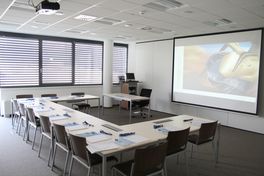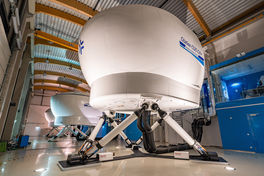We have more than ten years' experience in Cessna 525 series trainings. One size doesn't fit all. Our trainings are personalized to your individual needs and skill levels. The course concept is based on the experience we have gained from more than 750 successfully performed ratings. The FFS is located in our modern training centre in Neusiedl am See, 35 kilometres from Vienna International Airport. In addition to Europe´s most modern CJ1+ Level D Full Flight Simulator, we provide our customers with further training devices such as FMS trainers, ProLine 21 training stations and another CJ1+ fixed base simulator.
Pilot Training Courses
The Citation C525 Series is a single-pilot high-performance aircraft (SPA) and can be operated single- or multi-pilot. Aviation Academy Austria is privileged to offer trainings for both multi-pilot and single-pilot endorsements (MP and SP). The Citation Jet family comprises nine variants, from the legacy CitationJet to the Garmin 3000 equipped M2 and CJ3+. We are your C525 experts and offer training solutions for all variants!
The C525 ground course is taken in a small group. Smaller classes usually yield better results. Flying the C525 often means the transition to jet operations, which is why we refrain from inflexible CBT and focus on personal instruction, ensuring that each pilot acquires the knowledge, skills and competence levels required to successfully complete the theoretical exam.
The flight training part is done in our Citation CJ1+ Full Flight Simulator. During the sim-sessions all normal, abnormal, and emergency procedures are systematically explained and practiced until every pilot is proficient and feels well prepared. Our dedicated instructors have vast experience flying CJs and provide you with training scenarios which promote the best learning progress.
The type rating qualifies for C525 multi-pilot operations (MP). Candidates seeking the SP privilege take the transition course after the MP type rating. Additionally, the trainings for CJ2+ and CJ3 are included in the training program.
C525 Type Rating MP course outline:
- 40 hours ground course MP
- 1 Fixed Base Session as Pro Line 21 and FMS training
- 32 hours FFS training MP (8 sessions à 2h PF and 2h PM)
- 2 hours skill test PF
- 18 days duration
Entry requirements for C525 Type Rating course:
- ATPL(A) theory credit or HPA course
- Total time (incl. 70 hours PIC on aircraft): MP Copi 200 hours, MP PIC 500 hours, SP 500 hours
- Has or have held ME IR
- For MP: completed MCC course or holds / has held a MP rating
- Completion of an Advanced UPRT Course, in case no previous type rating for a Single Pilot High Performance Complex Aircraft or for a Multi Pilot Aircraft has been held.
The aim of the SP to MP transition course is to extend the privilege from C525 single-pilot operation to C525 multi-pilot operation. Pilots are trained to operate the C525 in the desired crew composition safely and efficiently, and to pass the skill test in accordance with EASA Part-FCL.725.
Type Rating C525 Transition Course SP to MP outline:
- 4 hours ground course
- 8 hours FFS training
- 2 hours skill test
Entry requirements Type Rating C525 Transition Course SP to MP:
- Successful completion of AAA TR C525 training course in single-pilot operation; OR
- In addition to the requirements above, the pilot shall:
- Valid single-pilot operation C525 TR license endorsement.
- Hold a certificate of satisfactory completion of an MCC course in aeroplanes; or
Hold a certificate of satisfactory completion of MCC in helicopters and have more than 100 hours of flight experience as a pilot on multi-pilot helicopters; or
Have at least 500 hours as a pilot on multi-pilot helicopters; or
Have at least 500 hours as a pilot in multi-pilot operations on single pilot multi-engine aeroplanes, in commercial air transport in accordance with the applicable air operations requirements
The aim of the MP to SP transition course is to extend the privilege from C525 multi-pilot operation to single-pilot operation. Pilots are trained to the level required to assimilate the knowledge and skills required to operate the C525 in a single pilot operation safely and efficiently, and to pass the skill test in accordance with EASA Part-FCL.725.
Type Rating C525 Transition Course MP to SP outline:
- 4 hours ground course
- 4 hours FFS training
- 2 hours skill test
Entry requirements Type Rating C525 Transition Course MP to SP:
- Successful completion of AAA TR C525 training course in multi-pilot operation OR
- Valid multi-pilot operation C525 TR license endorsement
- 500 hours of total flight time
The validity of the C525 type rating is one year. The revalidation of your rating (LPC – license proficiency check) can be performed within 90 days prior to the expiry date issued in the license.
If needed, we can offer a seat support (acting as pilot monitoring). Our examiners are registered with many civil aviation authorities and are able to perform proficiency checks or skill tests for all EASA member states.
If your type rating has expired, we offer renewal trainings to regain the level of proficiency required to safely operate the Citation 525. The amount of refresher training needed is determined on a case-by-case basis and depends on the on-type experience of the applicant, the amount of time elapsed since the expiry of the validity period of the rating and the pilot’s overall flight experience. Our training department reviews your documents and prepares a training program customized to your proficiency.
Please contact our sales department for more detailed information on the rules and procedures required by the different national authorities.
This course is designed for pilots who want to obtain an instructor's license - for type rating instruction in a simulator or in an aircraft (optionally). In the TRI/SFI course you will acquire the competence to design the theoretical and practical instruction of a Type Rating by addressing the individual learning behavior of student pilots. The Cessna Citation 525 is a single-pilot aeroplane, but is used commercially in multi-pilot operations. The training includes the acquisition of skills for teaching both, single-pilot and multi-pilot operations.
The TRI/SFI course comprises 3 modules:
Module 1: Teaching and Learning
Introduction to training and instructing techniques, candidate evaluation and lecturing. This module will be credited if the applicant already holds or has held a flight instructor license.
Module 2: Technical Course & FFS Training
The Technical Course enables the instructor to teach the type-specific syllabus for the C525. Particular attention to multi-crew cooperation or single-pilot operation are taught in respect of panel flow patterns, checklist strategy, workload management and task sharing.
Module 3: Assessment of Competence
An Assessment of Competence concludes the TRI/SFI course. Depending on the extend of the desired privileges, the assessment takes place at the FFS (TRI restricted) and/or at the aircraft (TRI unrestricted).
TRI restricted
- privilege of type rating instruction on a FFS
(privileges granted depending on license-issuing authority: Conducting landing training on an aircraft after the type rating, privilege of conducting training flights for recent experience - 3 take offs, approaches and landings during 90 days - on a FFS or an aeroplane)
TRI unrestricted
- privileges of a TRI restricted
- privilege of type rating instruction on an aeroplane
Entry requirements for TRI C525:
a) Hold a CPL, MPL or ATPL pilot license on the applicable aircraft category;
b) Have completed, within the 12 months preceding the date of application, 30 route sectors, including take-offs and landings, as PIC on the applicable aircraft type, of which 15 sectors may be completed in an FFS representing that type;
c) Have competed at least 500 hours flight time as pilot on aeroplanes, including 30 hours as PIC on the applicable type of aeroplane; OR hold or have held an FI certificate for multi-engine aeroplanes with IR(A) privileges.
Entry requirements for SFI C525:
a) hold or have held a CPL, MPL or ATPL pilot license on the applicable aircraft category
b) have completed the FSTD content of the applicable type rating course
c) have completed the proficiency check for the issue of the specific aircraft type rating in an FFS representing the applicable type, within the 12 months preceding the application
d) have completed at least 500 hours of flight time as PIC on single-pilot aeroplanes;
e) hold or have held a multi-engine IR(A) rating
f) completed, as a pilot or as an observer, within the 12 months preceding the application, at least:
(i) 3 route sectors on the flight deck of the applicable aircraft type (in a FFS or aeroplane); or
(ii) 2 line-orientated flight training-based simulator sessions conducted by qualified flight crew on the flight deck of the applicable type. These simulator sessions shall include 2 flights of at least 2 hours each between 2 different aerodromes, and the associated pre-flight planning and de-briefin.
The Multi Crew Cooperation Instructor Course is designed for pilots who want to instruct in an MCC course. Additionally, the MCCI course expands TRI privileges from instruction in the single-pilot environment to the multi-pilot environment.
MCCI course outline:
- 25 hours Teaching and Learning (this module will be credited if the applicant already holds or has held a flight instructor license.)
- 10 hours Technical Training
- 4 hours FFS training & Assessment of Competence
Entry requirements for the MCCI course:
- Must hold or have held a CPL(A), MPL or ATPL(A)
- Must have at least 1.500 hours experience in mult-pilot operations
Aviation Academy Austria offers Differences Training for all C525 variants!
Depending on the differences between the variants, the training comprises theoretical instruction, device training, FFS or aeroplane training. CJ, CJ1, CJ1+, CJ2, CJ2+, CJ3, CJ3+, CJ4 and M2 Differences Training is offered by us. The amount of training required for transiting from one C525 variant to any other variant is determined in the EASA OSD report. The report defines training / checking / currency, operational credits, and other elements bearing the status of rule and AMC.
- FMS Training Rockwell Collins 3000
- FMS Training Universal UNS1Lw
- Avionics Pro Line 21 Training
Operator Training Courses
In Business Aviation time is of the essence. Therefore, we help operators save time by performing company trainings and checks for them. All training will be configured according to your OMs and performed with maximum efficiency.
As defined in EASA PART-ORO.FC130 each flight crew member must complete a recurrent training relevant to the type of aircraft on which he or she operates. AAA customizes efficient and practice-oriented training which fulfils the requirements defined in the customer’s operations manual. The training is normally divided into a three-year cycle of ground school and flight instruction, covering all abnormal and emergency procedures. If needed, we can provide you with type-rated pilots who take over the duties of PM. Other modules may be included into the training.
Depending on the training specified by the airport authority and the operators’ manuals, the course familiarizes pilots with all aspects of operations at the respective airport, such as regulatory requirements, airport constraints, approach and departure operations, and human factors / CRM techniques that aid in safe flight operations. During an extended briefing, topics relevant to the operation are discussed, like AFM limitations, performance planning and criteria, the importance of thorough pre-planning for each arrival and departure, CRM issues regarding these operations, aircraft-specific procedures, and aircraft-specific performance calculations. In the subsequent practical FFS training all aspects of approach and departure operations as well as ground operations are trained. The FFS is equipped with up to date navigational and terrain information which is modelled in exact detail, providing a realistic environment.
Low Visibility Operations (LVO) training prepares pilots to practice ground operations, low visibility take-offs and approaches (normal/emergency ops) as approved by the respective authority.
Pilots who are nominated by an operator to act in the role of commander must perform a command course comprising theoretical knowledge instruction, simulator training and an OPC flown from the left-hand seat. In some EASA member states, the proficiency check can be combined with an ATPL(A) skill test. The duration and content of the course depend on the complexity and size of the operation, as well as the defined training syllabus in the customer’s operations manual.
Commanders whose duties require them to operate in either pilot seat and carry out the duties of a co-pilot, or commanders required to conduct training or checking duties, must complete additional training and checking as specified in the operations manual. This additional training and checking must include at least the following: an engine failure during take-off; a one-engine-inoperative approach and go-around; and a one-engine-inoperative landing.
Dry Lease
On our C525 Full Flight Simulator we offer two different dry-lease options. IOS course: This one-time course enables you to operate the FFS on your own. The course can be organized at short notice, in most cases right before your first dry-lease session. Panel Operator: Instead of attending an IOS course, you can also book a panel operator for your simulator session. Our experienced staff will take care of the FFS handling, while you can focus entirely on your training or examination.
FFS Specification
-

-
 AU-838_C525_UK_certificate_2024-12-16.pdf UK CAA FSTD Qualification Certificate Citation CJ1+ 551 KB
AU-838_C525_UK_certificate_2024-12-16.pdf UK CAA FSTD Qualification Certificate Citation CJ1+ 551 KB


